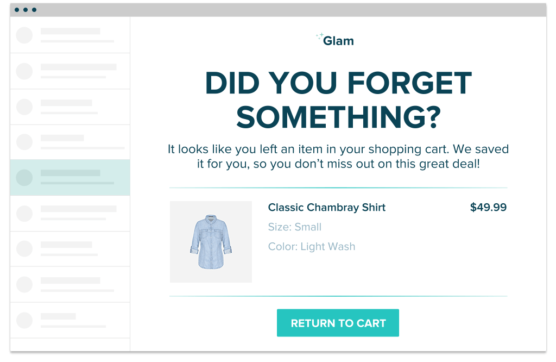Today, eCommerce follow up email plays a crucial role in acquiring new customers, retaining lost customers, and repeat sales. No matter how popular social media becomes, emails will always be the most convenient and effective medium to interact with your new as well as existing customers. Marketer and eCommerce website finds e-commerce follow up emails to be the best advertising tool in spreading awareness about their brand and product.
“About Us: SFWP Experts is an award-winning San Francisco web design company specialized in offering conversion-centric custom web design services to all sizes of businesses. Our professionals can create highly effective and fully responsive eCommerce as well as a standard website. We at SFWP Experts have a team of highly qualified content writing and marketing experts, dedicated to delivering high-quality and fact-based content to educate our audience about the latest trends, tools, tips, and more.“
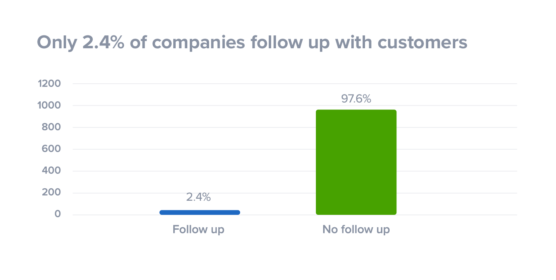 According to the recent research conducted by superoffice, out of 1000 companies, only 24 companies (2.4%) send follow up emails to their new and existing customers. Follow up emails act as the communication channel between customers and the e-commerce website. That why every eCommerce website needs to know what type of email it should send to its customers.
According to the recent research conducted by superoffice, out of 1000 companies, only 24 companies (2.4%) send follow up emails to their new and existing customers. Follow up emails act as the communication channel between customers and the e-commerce website. That why every eCommerce website needs to know what type of email it should send to its customers.
An effective follow-up email strategy will surely help you to outperform your competitor. Today few eCommerce websites are using various tools and software to automate their follow emails campaign.
In this article, we will help you to determine why it is important for you to send a follow-up email and what are the different types of follow up emails that your eCommerce website can send to recipients. We have listed different types of follow up emails like welcome email, abandoned cart email, Post-purchase follow up email and more.
If you are looking to reduce post-purchase dissonance of your customer then check our blog on 6 Efficient Tips To Reduce Post-Purchase Cognitive Dissonance
Why is it important to send follow up emails?
Many of you may not know but follow up emails are one of the most effective and powerful tools that can help you establish a good relationship with your new as well as existing customers. Crafting an effective follow-up email strategy can help you to increase your conversion rate and outperform your competitors.
In the eCommerce industry, follow up emails are generated and sent to engage and encourage potential customers for making another purchase, return on your eCommerce website, welcome new customers and more.
For different situations, there are different types of follow up email, for example, to interact with your newly joined customer you can send welcome emails, to re-engage the inactive customer you can send re-engagement email, abandoned cart email and more. Below we have discussed the different types of follow up emails that you can send to your customers.
Different Type Of Follow Up Email Every ECommerce Store Should Send
1. Welcome Email
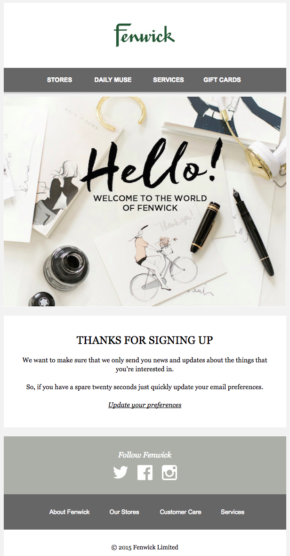
Today with the increase in e-commerce websites, most savvy online shoppers expect a welcome email as soon as they sign up or subscribe to a new e-commerce website. Your welcome email plays a crucial role in determining whether your new customer will become your potential customer or not. Because That’s the first time when you interact with your newly joined customer.
From the name you can identify the type of content, a welcome email will include. It is one of the most common types of emails that every user comes across in their daily life. Even if you are subscribing for any blog post or any newsletter you will get the welcome email. By sending a welcome email you try to show gratitude to your subscriber for becoming a potential lead.
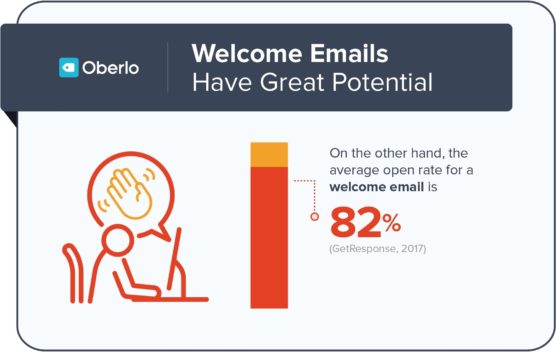
In the eCommerce industry, welcome email helps you to introduce your business in front of the newly joined lead. So, the message inside your welcome email can make and break the relationship with your customer. If you look at the above stats by oberlo, an average of 82% of the users open their email rate, which means there is a higher chance of your message getting viewed by your potential customer.
Today many marketers try to advertise their product through a welcome email. if your business is among them then right away you need to stop because these types of activities irritate customers and there are chances that your newly joined customer may opt-out from your email list.
If you are sending a welcome email to your new subscriber then highlight what type of email they will get in the future. In the same email, provide them a reason why they should not unsubscribe from your email list. And always maintain consistency after sending a welcome email. most of the time companies don’t interact with their subscribers after sending a welcome email and because of that, your new subscribers can forget about you.
Use below tips to crest an enticing welcome email for your subscribers:
- Thank your customer for joining your email list
- Set expectations and tell your subscriber what type of email they will get in future Future
- Tell about your e-commerce website by introducing yourself, you can include details about your niche ( but remember don’t advertise your product in front of your subscribers.
- If you have asked your subscribers to join your email list in return for some incentive. Then don’t hesitate or delay in delivering your incentive.
- Create attractive content inside your welcome
- In the same welcome email or the following email, you can ask your customer to share the details to get more updates about the upcoming offer, sales, and discounts.
- Don’t forget to include the social media icons in your welcome email
- The most important thing is don’t forget your customer after sending a welcome email. stay connected with them by sending various offer related emails and try to engage them by sending warriors newsletters.
2. Abandoned cart email
 Follow up email type also includes Abandoned cart email used by almost every eCommerce website. It is the most popular type of follow-up email eCommerce website sends after a customer adds the product in the checkout and forgets/ refuses to buy the product. Sending an abandoned cart email helps you to remind customers about the product they forget to purchase. It also keeps your customer’s memory fresh about the product.
Follow up email type also includes Abandoned cart email used by almost every eCommerce website. It is the most popular type of follow-up email eCommerce website sends after a customer adds the product in the checkout and forgets/ refuses to buy the product. Sending an abandoned cart email helps you to remind customers about the product they forget to purchase. It also keeps your customer’s memory fresh about the product.
According to the sales cycle, 75% of the online shoppers abandoned their cart in 2018. This type of situation occurs when customers are confused about the product, because of less product information, pricing and more.
Abandoned cart emails are generated automatically within 1 hour after a customer leaves the product in the cart. There is various automation software like Mailchimp, Getresponse and more available that can help you to automatically generate the abandoned cart email and send it at the right time when your customer can open your email and check the details.
You can also send the email manually but remember if your e-commerce website is getting Hughes traffic and orders then it is recommended to use automated software as it will make it easy for you to target a wide range of customers.
To make your abandoned cart email more effective you can offer some incentives (as shown in the image) like discounts, free shipping and more. and make sure that you’re creating a subject line that can attract your customer’s attention. For example subject lines like did you forget something, your product is missing you, and more will surely grab your user’s attention.
You can also use urgency triggers in your abandoned cart email to drive your customer back on your eCommerce website. For example, phrases like Only a few stocks have left, offer valid for a limited period and more can grab their attention. Don’t forget to add reviews and recommendations for that product. Including review in your email can act as a plus point which can help you to persuade your customer.
3. Post-purchase follow up email
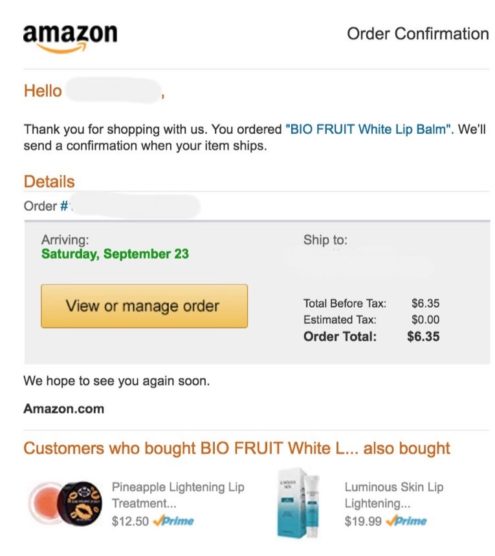
Many eCommerce websites think that their job is done after the customer successfully purchases from their store. But, in reality, the actual engagement starts after your customer buys the product from your eCommerce store. After purchase emails are the most anticipated ones because it contains all the details about the orders like shipment tracking id, order details and more.
You may think why you should send these types of follow up emails when every information is available on your website. Firstly these types of emails have a higher open rate because your customer wants to know every detail. You can also make use of post-purchase emails to advertise related products.
If you are looking to improve your eCommerce website post-purchase experience then check our blog on 9 Tips To Optimize Post-Purchase Customer Experience In 2020
Post-purchase follow up email can be used to thank your customer for purchasing from your store and encourage them to return and make another purchase for your eCommerce website.
You can create a sequence of post-purchase email which can include the order details, purchase experience feedback and more. You can also include a follow-up email that can educate your customers about the product. Including these types of strategies in your follow up email help can help you to reduce and minimize the feeling of post-purchase dissonance.
4. Re-engagement email for inactive/old customers
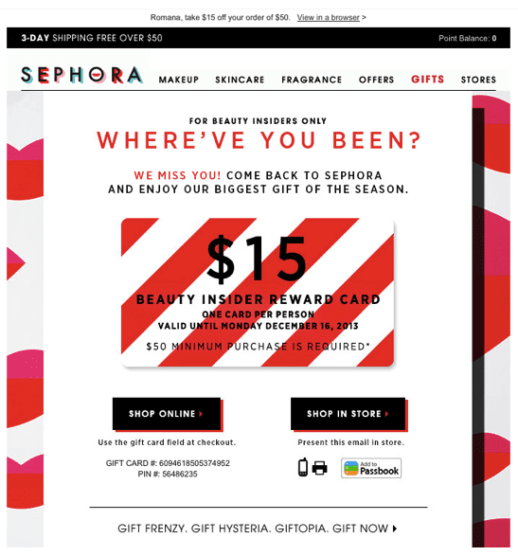
In the e-commerce industry customer engagement is one of the popular phrases used to engage inactive customers that haven’t bought any product from your store for a while. If you are looking to re-engage your inactive customer then a win-back email can be the best option to bring them back on your eCommerce website.
Most of the time these types of situations occur where your active customers become inactive and they stop visiting your eCommerce website and stop purchasing from your store. Worry not, you can re-engage your inactive or old customer by sending them a follow-up email after 30 or 60 days.
To make your email more effective craft an enticing subject line and content that can persuade your inactive customers to take action on your email. They are already familiar with your brand so it will be easy for you to engage them and convince them to return on your website.
Generally, the win-back email eCommerce website offers various incentives like discount code, free shipping, cashback offer, and many more. You can also make use of this strategy to persuade your customer from your win-back email. If you are offering an incentive to your customer then make sure to add urgency trigger like valid till X date, coupon expiry date and more
How inactive customers can become loyal customers?
Remember Your loyal customers are the ones who will help you to increase your brand awareness, sales, revenue and more. Compared to other customers your loyal customer will never hesitate to buy from you again. They are the ones who will refer your eCommerce website to their friends and family. And if your eCommerce website is recommending the product to the customer then they will surely show interest in your product.
Converting your new customer into loyal customers requires more effort and time. Before converting them into loyal customers you need to engage them and tell them about your brand and products. whereas your existing customer already knows about your eCommerce website, so engaging a lost customer and converting them into a loyal customer can be a much easier job for good e-commerce website
You’re lost customers already know about your e-commerce website that’s why it’ll be easy for you to convert them into loyal customers. Just you have to determine why they stopped visit8ng your website, identify your mistake, try to resolve them by showing that you have updated your process and encourage them to visit you back on your website.
5. Subscription expiry email
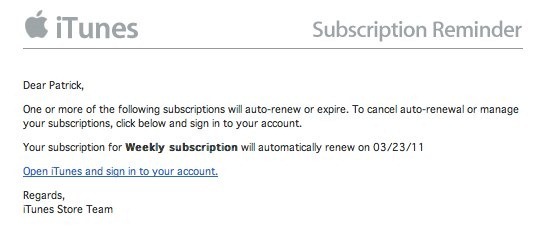
If your business is into selling subscriptions online then you need to remind your customer about the subscription expiry date. Most of the time customer is not aware of their subscription expiry date or they forget to retake the subscription. Sending this type of remainder email helps your customers to know when their subscription ends.
When your customer purchases any product you can ask then to enable the email reminder option. You can plan a sequence of an email where in the first email you can remind your customer about the expiry date. If your customer refuses to buy the subscription then you can send them another email and offer them some incentive like discounts or coupon code. You can make use of automated tools and software which will automatically generate the email after analyzing your purchase data.
Conclusion
Follow up email is an essential part of a successful eCommerce business whether you are welcoming new customers or sending them an abandoned cart email. Every follow up email campaign adds up and helps you to create a good relationship with your customers. It also helps you to convert your existing customer into a loyal customer.
Therefore, if you want to succeed in the eCommerce industry then you need to send an automated follow-up email to your customers. using these types of emails you can appreciate your customers and show them that you are watching their moves (reviews, purchase, etc), appreciating it and it matters most. Communicating with your customers through email helps you to build a strong connection with your customers.
Above we have mentioned some important types of follow up emails that every eCommerce website should send to their customers. If you are operating these emails manually then it is recommended to shift to the automated process. Shifting to the automated process will help you to automatically generate the follow-up email as soon as a customer performs some activity in your eCommerce store. It will automatically detect the right time to send the email. It will also ease the process of handling the email campaign.
Frequently asked questions:
1 How do you engage an inactive customer?
In the e-commerce industry customer engagement is one of the popular phrases used to engage inactive customers that haven’t bought any product from your store for a while. If you are looking to re-engage your inactive customer then a win-back email can be the best option to bring them back on your eCommerce website.
- Analyze your data and figure out why customers didn’t return on your eCommerce website. depending on how they segment them into different groups.
- Before contacting your customer determine what you want to say to your customer through email.
- Create an enticing subject line that can clearly show your goal
- To make your re-engagement email more effective run the A/B test and determine the effectiveness of the email
- In the same email or the follow-up email show what changes you made on your eCommerce website. How you automated and optimized your eCommerce store functionality.
- You can also use the re-engagement email to reintroduce your brand to an inactive customer
- Make use of the urgency trigger in your email to grab your inactive customer’s attention.
2. How do you welcome someone via email?
Your welcome email plays a crucial role in determining whether your new customer will become your potential customer or not. Because That’s the first time when you interact with your newly joined customer. Use below tips to crest an enticing welcome email for your subscribers:
- Thank your customer for joining your email list
- Set expectations and tell your subscriber what type of email they will get in future Future
- Tell about your e-commerce website by introducing yourself, you can include details about your niche ( but remember don’t advertise your product in front of your subscribers.
- If you have asked your subscribers to join your email list in return for some incentive. Then don’t hesitate or delay in delivering your incentive.
- Create attractive content inside your welcome
- In the same welcome email or the following email, you can ask your customer to share the details to get more updates about the upcoming offer, sales, and discounts.
- Don’t forget to include the social media icons in your welcome email
- The most important thing is don’t forget your customer after sending a welcome email. stay connected with them by sending various offer related emails and try to engage them by sending warriors newsletters.
3. When should you send a re-engagement email to an inactive customer?
Re-engagement email plays a crucial role in bringing back your inactive customers on your e-commerce website. That’s why it is important to know the proper timing to send a re-engagement email to your inactive customers. From the word inactive you can recognize that you have to contact a group of customers who didn’t visit your eCommerce website, didn’t make any purchases for a long time. so you can analyze your data and identify a group of customers that are inactive fast 30 or 60 days. you can create a sequence of emails and start sending them after 30 or 60 days depending on your customer’s inactive duration.
4. How do you write a good follow up email?
In the eCommerce industry, Follow up emails are generated and sent to engage and encourage potential customers to make another purchase, return on your eCommerce website, welcome new customers and more. If you are planning to Create an attractive follow-up email for your eCommerce business then we recommend you to follow the below steps:
- Firstly, we would recommend selecting the right email service provider for your eCommerce business. Selecting the right email service provider will allow your email to land in your recipient’s inbox.
- Craft enticing and goal-specific subject line for your eCommerce business.
- Focus on your opening line. Creating a monotonous opening line can fail you’re following up on an email campaign.
- Make sure all the links inside your Follow up email is redirecting your recipient to the right page.
- Create your email content using less jargon and make sure the content inside your email is easily understandable.
- Try to use fewer infographics and more text content (Sometimes images disappear in the mobile device due to compatibility issues.
- Use less than 300 words in your follow up email.
- Run various tests to see how your email appears on different screens.
5. How to craft the perfect post-purchase Follow up sequence email for your customer?
Many eCommerce websites think that their job is done after the customer successfully purchases from their store. But, in reality, the actual engagement starts after your customer buys your product. Post-purchase follow up email can be used to thank your customer for purchasing from your store and encourage them to return and make another purchase for your eCommerce website. You can create a sequence of an email to optimize the post-purchase experience. Below are the tips that you can that you can use
- As soon as a customer purchases from any e-commerce store they expect an order confirmation email. make sure that you send the order confirmation email immediately with all the details like shipment tracking ID, product details, estimated delivery time and more.
- In the next sequence email, you can send a micro-content to educate your audience about the product. sending this type of email helps you to gain your customer Trust and reduces the chances of Post-purchase dissonance.
- Next, you can ask you a question to get feedback about their purchase experience and the product. You can send them a review request email.
- Don’t forget to send a replenishment reminder email. you can analyze your data and depend on that you can segment a group of customers that you have to target.
